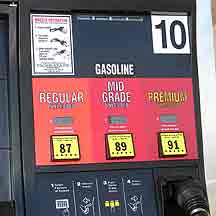With today's high cost of gasoline, there is no need to pay extra for higher octane gasoline than your engine requires.

The octane rating tells how much the fuel-air mixture can be compressed before it spontaneously ignites via compression rather than by the spark plug, resulting in knocking and pinging. The more compression, that is the higher the compression ratio, the higher the octane fuel needed. Lower-octane gas can handle the least amount of compression before igniting.
Among other things, engineers can produce more horsepower from the same displacement engine, that is liters, by increasing compression ratio.
Octane ratings are given by Antiknock Index or AKI. You've probably seen this posted on the pump. The AKI is the average of two ratings - Research Octane Number (RON) and the Motor Octane Number (MON). The RON corresponds with low-speed, mild-knocking test conditions and MON relates to high-speed, high-temperature knocking conditions and part-throttle operation. You may also see the equation, AKI = RON/2 + MON/2, also posted.
Most gasoline stations offer three octane grades: regular (usually AKI = 87), mid-grade (usually AKI = 89) and premium (usually 91 or 94). When you mix gasoline grades, you get an average AKI. For example, a half tank of regular and premium each, you get the average AKI of the two, or a 91 octane rating.
Octane rating are not consistent across the country. One state may require a minimum octane rating of 92 for premium gasoline, while another may allow 90 octane to be called premium. Make sure to check the octane rating on the yellow sticker on the gas pump instead of relying on the name "premium" or "regular." Octane ratings are lower in the Rocky Mountain states because "effective" compression ratios are less at higher altitudes.
Buying a gasoline with a higher octane rating than needed is a waste of money. Using a higher octane than recommended in the owner's manual offers absolutely no benefit. The engine will not perform better, get more MPGs or run cleaner.
As a rule, high octane gasoline does not outperform regular octane in preventing engine deposits from forming, removing them, or cleaning the engine. Indeed, the EPA requires that all octane grades of all brands of gasoline contain engine cleaning detergent additives to protect against the build-up of harmful levels of engine deposits during the vehicles expected lifetime.
The only time you might switch to a higher octane level is if your engine knocks or pings when running on the recommended fuel. This is especially rare on today's engines with electronic engine management systems that include knock sensors that compensate for lower octane gasoline and operating conditions that could produce knocking and pinging.
While regular octane is recommended for most engines, some high compression engines, usually found in sports cars and luxury cars, might need mid-grade or premium gasoline to prevent knock.
If you experience knocking or pinging, typically under heavy load conditions as when climbing a steep hill while towing, you might try a higher octane gasoline. If the knocking or pinging continues after one or two fill-ups, you may need a tune-up or some other repairs. After that work is done, go back to the lowest octane grade at which your engine runs without knocking.
Occasional light knocking or pinging will not harm your engine, and does not indicate a need for higher octane. Do not ignore severe knocking. A heavy or persistent knock can result in expensive engine damage.
Will aftermarket octane booster additives you can buy in a store will not improve performance? Probably, not if you use the correct gasoline grade to begin with.




